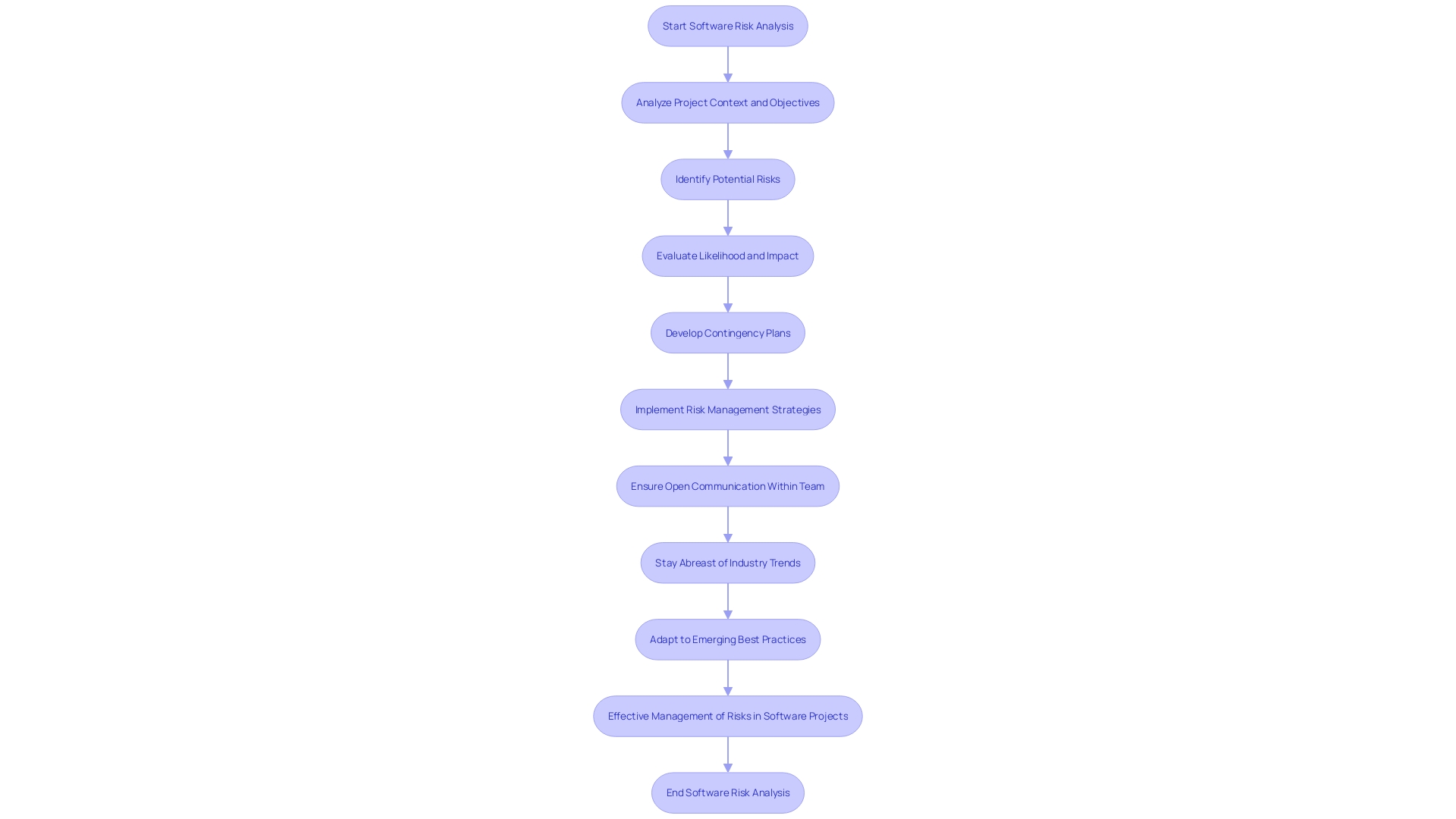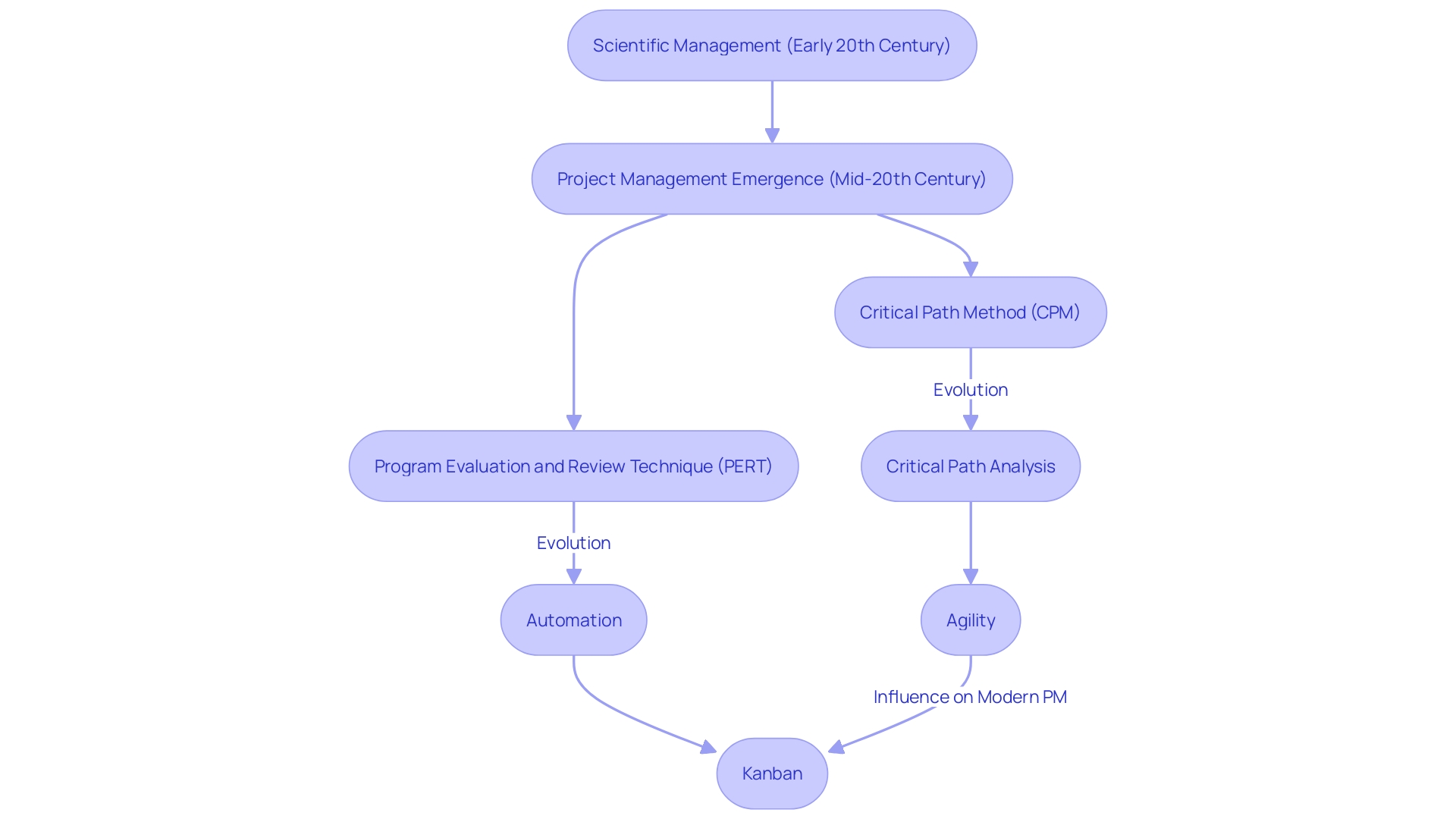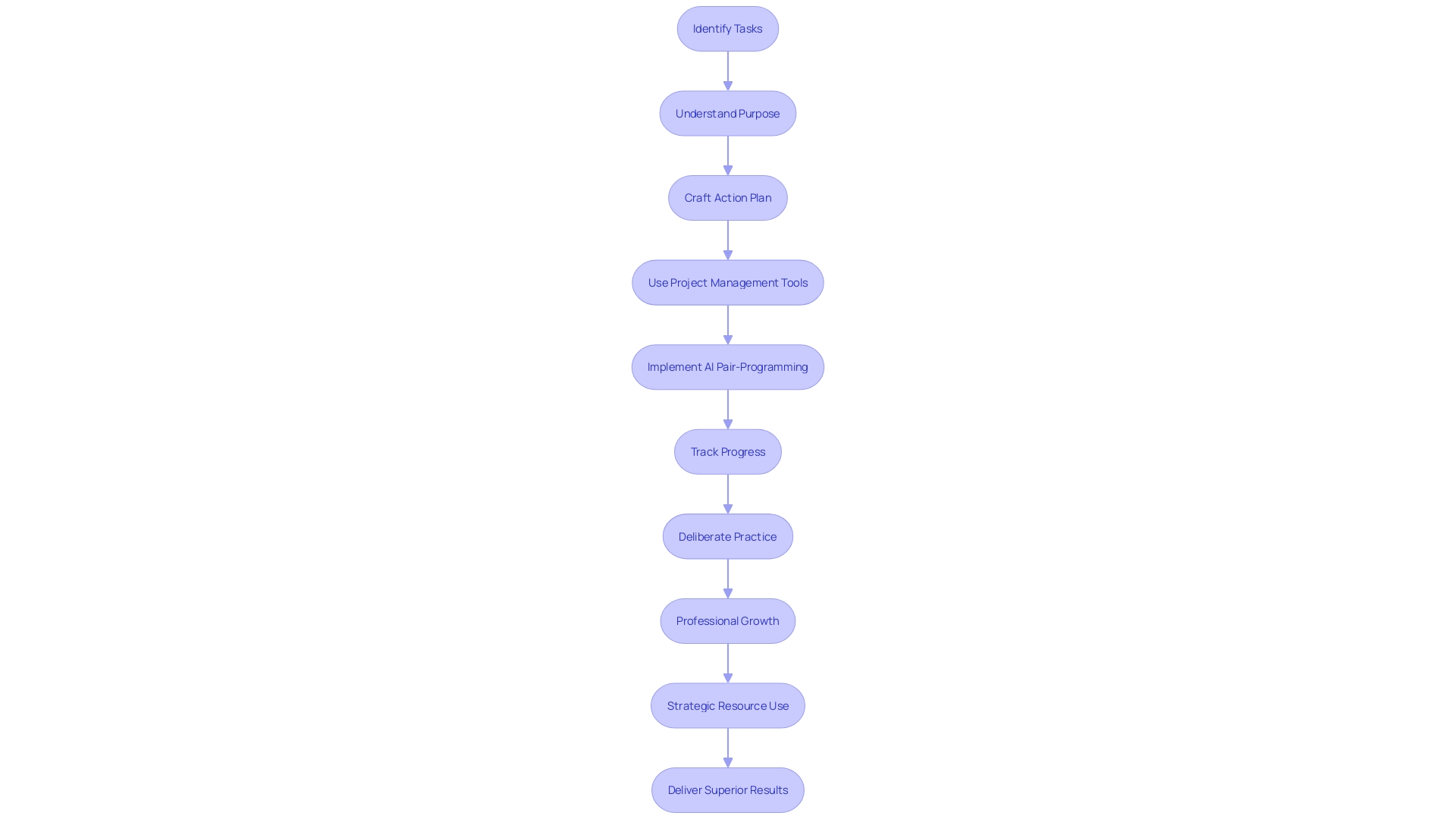Introduction
Embarking on the software development journey requires a meticulous understanding of the project's scope and a well-defined set of goals. It's not just about knowing what features to include; it's about recognizing the problems your software aims to solve and the specific needs it will address. Implementing software engineering principles is crucial for creating reliable, cost-effective systems that deliver on stakeholder expectations.
A clear definition of objectives, audience, and desired outcomes is paramount, and this clarity is echoed by professionals in the field who advocate for simplifying processes to add early value to users, circumventing the pitfalls of traditional project-based approaches that often lead to delays. The consensus among experts is that a comprehensive understanding of the problem domain sets the stage for success. This article explores key aspects of software development, including team size and roles, talent acquisition, team structuring, tools and work environment, communication and collaboration, team ownership, risk management, defining key performance indicators, and providing feedback and monitoring progress.
By delving into these topics, software development teams can enhance their approach and drive exceptional outcomes in their projects.
Understanding the Project Scope and Requirements
Embarking on the software development journey requires a meticulous understanding of the project's scope and a well-defined set of goals. It's not just about knowing what features to include; it's about recognizing the problems your software aims to solve and the specific needs it will address. The Software Engineer Book of Knowledge (SWEBOK) emphasizes the importance of grasping the entire lifecycle of software development, from conception to retirement, and the necessity for a systematic approach to transform requirements, designs, and code into valuable software solutions.
Implementing software engineering principles, as noted in discussions of industry evolution, is crucial for creating reliable, cost-effective systems that deliver on stakeholder expectations. A clear definition of objectives, audience, and desired outcomes is paramount, and this clarity is echoed by professionals in the field who advocate for simplifying processes to add early value to users, circumventing the pitfalls of traditional project-based approaches that often lead to delays.
The consensus among experts is that a comprehensive understanding of the problem domain sets the stage for success. This understanding involves collaborating with stakeholders to identify and prioritize needs, which may include conducting interviews and workshops. A case in point is the experience shared by a client of TechSolutions, where a combination of expertise, collaboration, and innovation ensured the project met all deadlines and stayed within budget, illustrating the tangible benefits of a clear, well-communicated project scope.
In sum, the foundation of any successful software development project lies in a thorough comprehension of the requirements, which must be unambiguous, testable, and aligned with the realities of the problem at hand. This groundwork facilitates the creation of software that not only meets but exceeds user expectations while maintaining efficiency and reliability throughout its lifecycle.
Determining Team Size and Roles Needed
Building a cohesive software development team requires a nuanced understanding of both technical and organizational principles. Fred Brooks, in his seminal work 'The Mythical Man-Month', famously stated that "Adding manpower to a late software project makes it later." This insight underscores the complexity of communication that grows with team size, emphasizing the importance of small, skilled teams and clear communication channels for project success.
The architecture of software teams mirrors the system they are creating. A split team may lead to divergent products, whereas a unified team is more inclined to produce a cohesive output. This structural decision is crucial as the organization's communication patterns often replicate within the system's design.
As the Agile methodology suggests, breaking down projects into manageable 'sprints' and fostering daily collaboration between developers and stakeholders can lead to more rapid and flexible development processes.
When considering team expansion, one must be wary of Dunbar's number, which suggests a cognitive limit to the number of stable relationships an individual can maintain—typically around 150. Scaling beyond this number can lead to decreased productivity due to the 'noise' of excessive meetings and the need for catch-up sessions.
Furthermore, the 'bus factor' is an essential consideration. It assesses the risk associated with knowledge being concentrated within a few team members. A low bus factor indicates a precarious situation where the incapacitation of a few could derail the project, highlighting the need for knowledge sharing and collaboration.
While the global pool of developers is growing, with approximately 13.4 million professional developers worldwide by 2023, it is not merely about quantity. The composition, hierarchy, and size of a software team are critical to the project's success, affecting everything from development velocity to product quality. Therefore, when determining team size and roles, one must carefully balance the workload, the need for diverse skills, and the imperative to maintain efficient communication and a high level of conceptual integrity within the team.
Hiring the Right Talent for Your Team
Selecting the right talent is a pivotal step in cultivating a successful software development team, especially for startups aiming to scale in 2024. A deep dive into the candidate's proficiency with pivotal programming languages like JavaScript, Python, or Java is indispensable, as is their ability to write, test, and maintain robust, maintainable, and scalable code. The hiring process should be comprehensive, incorporating technical assessments that rigorously test their coding acumen and interviews that gauge their ability to collaborate effectively.
As software developers often work in tandem with designers, product managers, and project managers, their interpersonal skills are just as critical as their technical skills. This balanced approach to recruitment can set the stage for the development of high-quality software and position startups to navigate the evolving landscape of IT hiring trends and the push towards automated quality control.
Structuring Your Engineering Team for the Project
When crafting a software engineering team, the key lies not only in selecting the right size and roles but also in designing an architecture that mirrors your organizational communication. This is more than a mere HR decision; it's about shaping a team that can produce a cohesive product. Break down larger teams into specialized sub-teams, each focusing on distinct aspects of the project.
This strategy encourages optimal collaboration and efficiency, akin to the trifecta model where engineering, product, and UX experts unite to craft a solution that is technically sound, user-centered, and attractive.
Assign a leader for each sub-team to streamline communication and manage project milestones, ensuring every group's efforts contribute to a unified end product. Reflect on the Hoover Dam's construction, where a multitude of specialists worked under a system of delegated authority to create a massive and unified structure. Similarly, in software development, when two teams merge their expertise, they're more likely to integrate their products effectively, provided there's clear communication.
Remember, as your project grows, so does its 'surface area' and 'volume'—the number of contribution opportunities and the depth of knowledge required. Effective team structuring is paramount to maximizing each member's impact while maintaining the project's momentum. As the legendary 'The Mythical Man-Month' suggests, adding manpower to a late software project only makes it later, emphasizing the significance of a well-structured team from the outset.
Providing Tools and a Good Work Environment
Harnessing the power of AI pair-programming tools like GitHub Copilot has brought a transformative impact on the productivity levels of software developers, regardless of their experience. These tools leverage large language models to provide predictive code suggestions based on the developers' current work context, enhancing not only task efficiency but also the quality of the final product. The benefits are multifaceted, spanning reduced cognitive load, increased enjoyment, and accelerated learning curves, especially for junior developers.
In the realm of software development, a well-rounded measure of productivity transcends the basic metrics of lines of code or bug fixes. A comprehensive evaluation includes assessing the impact of the work, the quality of the code, and the ability to foster effective collaboration. Such holistic approaches demand a focus on the developer experience (DevEx), which aims to create an environment where writing code is not just about the output but also about the process being as smooth and enjoyable as possible.
In terms of creating the optimal work environment, the insights from the Developer Experience Lab, a collaboration between Microsoft and GitHub, are particularly revealing. They suggest that the key to bolstering developer output is not simply to amplify expectations but to enhance the developer experience. A conducive work environment goes beyond ergonomic chairs or well-lit rooms; it also includes access to cutting-edge tools that automate and improve the code-writing process, such as predictive AI and comprehensive code-completion systems that offer real-time suggestions and facilitate seamless collaboration.
Moreover, the latest developments in software quality control indicate a shift towards automated systems that provide a chain of custody for code. This enables a better understanding of code progression through the systems and allows for more efficient remediation of issues. This is in line with industry expert Grace White's view that developers thrive in environments that offer autonomy and flexibility, underscoring the importance of a supportive culture that enables developers to work in the manner that best suits their productivity.
Improving Team Communication and Collaboration
Leveraging the lessons from the monumental Hoover Dam project, contemporary software development teams can similarly aim for exceptional achievements by valuing documentation maintenance as the bedrock of effective communication. This approach is echoed in the development of digital communication tools, which have evolved from the groundbreaking introduction of email to the dynamic exchanges facilitated by instant messaging platforms. Today's agile software development is rooted in these communication advancements, providing developers with robust tools like Git and Mercurial to foster collaborative coding practices.
In the realm of software development, active listening is recognized as a catalyst for enhancing team collaboration, boosting productivity, and nurturing innovation. Engaging in open dialogue, as highlighted by software development expert Richard Donovan, allows for a multitude of viewpoints to be considered, paving the way for creative solutions. Moreover, establishing a communication culture where information is shared in a digestible and skimmable manner ensures that all team members can opt-in to updates without feeling overwhelmed, thereby keeping the team aligned and focused on common objectives.
Pair programming and code reviews are practical embodiments of this collaborative ethos, allowing developers to share knowledge, provide immediate feedback, and collectively push towards higher quality code. By adopting these practices, teams can mirror the efficiency and success of iconic engineering feats like the Hoover Dam, which was completed ahead of schedule despite the immense challenges it faced.
Underpinning these practices are key insights into developer productivity, with research indicating that AI pair-programming tools can significantly enhance a developer's output across various metrics, including task time and product quality. This shift towards prioritizing the developer experience suggests a future where the well-being of software engineers is just as important as their productivity, ensuring sustainable growth and innovation in the field of software development.

Empowering Team Ownership and Accountability
Fostering a culture of autonomy and responsibility within software development teams is akin to constructing a robust and enduring edifice, much like the Hoover Dam — each team member's contribution is vital to the integrity of the whole. By entrusting developers with the authority to manage their components, akin to the self-sufficient units in a design system, teams can function more effectively and with greater innovation.
Grace White, head of design and development at Lilo, emphasizes that programmers thrive on autonomy and the flexibility to work in ways that best suit their productivity. This mirrors the broader trend towards flexible work environments, where allowing remote work or flexible hours is becoming the norm rather than the exception. The importance of autonomy is further validated by the growing role of AI in software development, which, rather than replacing developers, can empower them to focus on creative solutions and complex problem-solving.
To enable developers to take full ownership of their work, clear performance metrics and regular maintenance — much like the annual updates to manufacturing lines referenced by industry veterans — are necessary to ensure that both the team's skillset and the technology they use remain state-of-the-art. This approach not only motivates developers but also aligns with modern best practices that prioritize a sustainable Developer Experience (DevEx), which is critical to the creation of high-quality, reliable, and secure software systems.
By instilling a sense of ownership and fostering a continuous learning environment, teams are equipped to face large-scale challenges with agility and confidence, ultimately driving exceptional outcomes in software development.
Managing Risks and Challenges
Software development projects, akin to architectural marvels like the Hoover Dam, require meticulous planning and risk management to ensure they are completed successfully. Risk in software development can arise from a multitude of sources, such as technical complexities, shifting requirements, or resource constraints. To combat these risks, a methodical approach to Software Risk Analysis is crucial.
It involves analyzing the project context and objectives, identifying potential areas of concern, and evaluating the likelihood and impact of risks.
The goal of risk management is to minimize disruptions and prepare for potential challenges, not to eradicate all risks, which is often impractical. Regular risk assessments and the development of contingency plans are essential practices. They provide a framework for addressing potential setbacks and maintaining project stability.
Open communication within the team is also vital, as it allows for the expression of concerns and the suggestion of innovative solutions. This is particularly important in an era where the software serves as the backbone of numerous enterprises. Improving the developer experience, not just productivity, can lead to more sustainable outcomes, as indicated by research from the Developer Experience Lab, a Microsoft and GitHub initiative.
Staying abreast of industry trends and best practices is equally important. It informs the team of new advancements and potential hurdles in the field, enabling them to be more proactive in their approach. For instance, the recent $100 million Series C funding of the OpenAI-backed legaltech startup Harvey signifies the increasing confidence in Ai's potential to revolutionize professional services, suggesting that teams should consider the implications of incorporating AI into their software solutions.
Therefore, by effectively managing risks and challenges and fostering a supportive team environment, software development projects can progress smoothly, mirroring the success of historical engineering feats.

Defining Key Performance Indicators (KPIs)
Understanding the historical evolution of productivity management, from Frederick Taylor's Scientific Management in the early 20th century to modern project management methodologies such as the Critical Path Method (CPM) and the Program Evaluation and Review Technique (PERT), provides a backdrop for today's software development KPIs. In the fast-paced world of software engineering, where knowledge work reigns, establishing and tracking Key Performance Indicators (KPIs) is more than just a task; it's an art form that requires a deep understanding of the unique dynamics within a software development team.
Enlightened by the insights from academic research, which underscores the significance of performance evaluation, and reflecting on industry needs for continuous performance improvement, software development teams are tasked with selecting KPIs that resonate with the project's aims. Metrics such as code quality, punctual delivery, customer contentment, and team productivity are not just numbers – they narrate the story of a project's trajectory, highlighting the intricacies and the collective efforts of the team.
Developer productivity is a tapestry interwoven with factors like tooling, technical debt management, and minimizing disruptions such as unnecessary meetings. Research suggests prioritizing these elements can make a tangible difference in productivity. By capturing, tracking, and analyzing qualitative metrics, software teams can gain a profound understanding of their systems' behaviors and limitations, thereby unlocking potential improvements and fostering an environment where creativity and commitment to company values are as valued as the code written.
As industry narratives from tech giants like Google and LinkedIn to mid-sized companies like Peloton unfold, it becomes evident that the quest for effective software development metrics is universal. The challenge lies in choosing metrics that accurately reflect productivity without being susceptible to manipulation or causing harm. In this endeavor, the stories of success and missteps shared by these organizations serve as valuable lessons for software teams aiming to prioritize the right projects and measure their engineering efficiency.

Providing Feedback and Monitoring Progress
Cultivating a high-performing software development team requires more than just routine task assignments; it demands a strategic approach to growth and productivity. By focusing on qualitative metrics, team leaders can offer more than superficial feedback—they can provide insights that genuinely foster improvement and skill development. This involves establishing a clear understanding of why certain tasks are necessary and what events or needs precipitated them.
Once these tasks are identified, a careful action plan can be crafted.
According to renowned psychologist K. Anders Ericsson, the path to expertise is paved with structured, deliberate practice that includes specific tasks and timely feedback. It's this kind of intentional effort that can transform a competent developer into an exceptional one. For team leaders, this means not just assigning tasks, but ensuring those tasks contribute to each developer's deliberate practice and professional growth.
To this end, project management tools can be invaluable in tracking progress and identifying bottlenecks, as evidenced by the emerging. NET Aspire platform's capabilities in streamlining workflow. The use of AI pair-programming tools like GitHub Copilot has also been shown to boost developer productivity across the board.
These tools provide intelligent code suggestions, reducing task time and improving product quality while also enhancing the learning experience for developers.
Ultimately, the key to continuous improvement lies in a nuanced understanding of task definition, actionable planning, and the strategic use of both human and technological resources to guide your team to deliver superior results.

Conclusion
In conclusion, successful software development requires a thorough understanding of the project's scope and goals, as well as the implementation of software engineering principles. By forming small, skilled teams with clear communication channels and breaking down projects into manageable sprints, development processes can become more rapid and flexible.
Hiring the right talent, considering proficiency in programming languages and interpersonal skills, is crucial for building a successful software development team. Additionally, structuring the team with specialized sub-teams and assigning leaders fosters collaboration and ensures a unified end product.
Providing tools and a conducive work environment, such as AI pair-programming tools, can greatly enhance developer productivity. Prioritizing the developer experience and creating a smooth work process are essential for comprehensive evaluation and improvement.
Improving team communication and collaboration through documentation maintenance and open dialogue promotes innovation. Pair programming and code reviews facilitate knowledge sharing and result in higher quality code.
Empowering team ownership and accountability by allowing developers to manage their components and providing clear performance metrics motivates developers and ensures up-to-date technology.
Managing risks and challenges through risk analysis, open communication, and staying informed of industry trends helps maintain project stability. Defining key performance indicators (KPIs) that align with project aims and prioritizing elements like code quality and punctual delivery drive productivity.
Providing feedback and monitoring progress strategically fosters improvement and skill development. Project management tools and AI pair-programming tools aid in tracking progress and enhancing the learning experience.
By following these principles and best practices, software development teams can enhance their approach, drive exceptional outcomes, and deliver reliable systems that meet stakeholder expectations.





